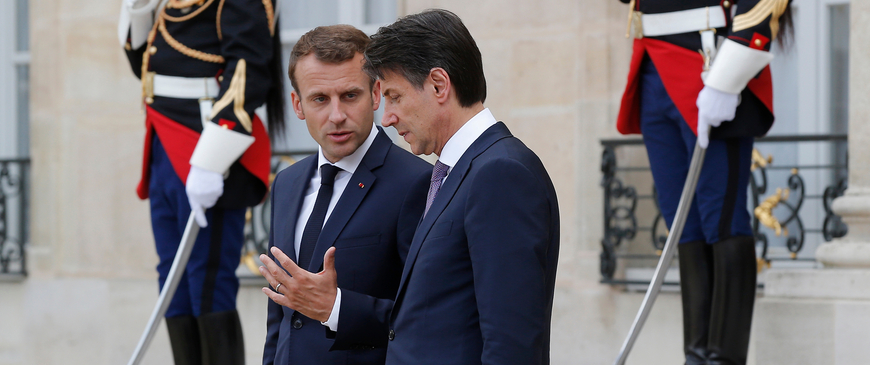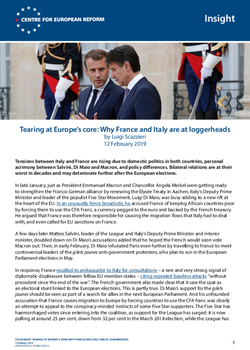
Tearing at Europe's core: Why France and Italy are at loggerheads
Tensions between Italy and France are rising due to domestic politics in both countries, personal acrimony between Salvini, Di Maio and Macron, and policy differences. Bilateral relations are at their worst in decades and may deteriorate further after the European elections.
In late January, just as President Emmanuel Macron and Chancellor Angela Merkel were getting ready to strengthen the Franco-German alliance by renewing the Élysée Treaty in Aachen, Italy’s Deputy Prime Minister and leader of the populist Five Star Movement, Luigi Di Maio, was busy adding to a new rift at the heart of the EU. In an unusually fierce broadside, he accused France of keeping African countries poor by forcing them to use the CFA Franc, a currency pegged to the euro and backed by the French treasury. He argued that France was therefore responsible for causing the migration flows that Italy had to deal with, and even called for EU sanctions on France.
A few days later Matteo Salvini, leader of the League and Italy’s Deputy Prime Minister and interior minister, doubled down on Di Maio’s accusations, adding that he hoped the French would soon vote Macron out. Then, in early February, Di Maio infuriated Paris even further by travelling to France to meet controversial leaders of the gilets jaunes anti-government protesters, who plan to run in the European Parliament elections in May.
In response, France recalled its ambassador to Italy for consultations – a rare and very strong signal of diplomatic displeasure between fellow EU member-states – citing repeated baseless attacks "without precedent since the end of the war”. The French government also made clear that it saw the spat as an electoral stunt linked to the European elections. This is partly true. Di Maio’s support for the gilets jaunes should be seen as part of a search for allies in the next European Parliament. And his unfounded accusation that France causes migration to Europe by forcing countries to use the CFA franc was clearly an attempt to appeal to the conspiracy-minded instincts of some Five Star supporters. The Five Star has haemorrhaged votes since entering into the coalition, as support for the League has surged: it is now polling at around 25 per cent, down from 32 per cent in the March 2018 election, while the League has doubled its support to 35 per cent. The coalition is fragile, and if the League performs strongly in the European elections Salvini could be tempted to pull the plug on the government and push for an early general election.
Di Maio’s accusation was not just an isolated electoral stunt. It marked the latest episode in the sharp deterioration in relations between Rome and Paris.
However, Di Maio’s accusation was not just an isolated electoral stunt. It marked the latest episode in the sharp deterioration in relations between Rome and Paris since the populist Five Star-League coalition took power in May 2018. It is tempting to view the Franco-Italian spat as simply a reflection of the deterioration in relations between Italy and its traditional partners that Rome’s new government has provoked. But relations with Germany are nowhere near as poor as they are with France. The deep personal antipathies between Salvini and Di Maio on the one side, and Macron on the other, have exacerbated genuine policy differences.
The most public source of tension between Paris and Rome is migration policy. Even the previous centre-left Italian government complained that France had not shown Italy much solidarity. But disagreements have escalated dramatically under Italy’s populist government, which has sought to capitalise on what the Italian public perceives as a lack of French and European solidarity.
The previous Italian government wanted other member-states to open their ports to ships carrying people rescued at sea, and to accept a share of those disembarking in Italy. Salvini has maintained these demands, making it very difficult for ships to off-load these people in Italy, and has escalated the rhetorical confrontation. A coalition of willing member-states has on several occasions agreed to accept asylum seekers from ships that were being prevented from docking in Italy, but always on an ad-hoc basis. Meanwhile, the EU has dropped its idea of ‘controlled centres’ in member-states where migrants’ applications could be processed "on the basis of a shared effort". Macron has been the most vocal opponent of Salvini’s migration policy from the start, accusing Italy of "cynicism and irresponsibility" for refusing to let rescue ships dock.
The Five Star and the League have hit back, accusing Macron of hypocrisy over migration. In particular, they have criticised French efforts to turn back migrants coming across the border from Italy, which have long been a source of tension. In 2011, France re-instated Schengen border checks, thereby preventing Italy from sending migrants north to avoid the responsibility of processing them. But tensions have heightened recently after several French police operations gained wide publicity in the Italian media. In one high profile incident in October 2018, French police entered Italy to return migrants, a move that Salvini described as a "possibly" hostile act. The French authorities said the episode was an error, but the damage was done. These incidents have made it easy for Salvini and Di Maio to successfully portray Macron as hypocritical: Italian public opinion does not concern itself with the intricacies of the Dublin regulation, which determines which EU member-state is responsible for managing asylum applications, but focuses on the images of Macron praising European solidarity while French policemen repulse asylum seekers at France’s borders.
The spat over migration is only the most visible manifestation of Franco-Italian friction.
The spat over migration is the most visible case of Franco-Italian friction. Less prominently, the two countries have also clashed over Libya. Rome is still annoyed by the French and British-led intervention in 2011, which it initially opposed. Many Italians believe that France intervened because it sensed an opportunity to displace Italy as the dominant player in its former colony. France and Italy have also pursued different approaches to stabilising the country. In part their differences are about process: France has led a controversial push for early elections while Italy supports a slower approach centred on mediation, and has felt sidelined. However, there are also substantive policy differences over how to best stabilise Libya. Paris has supported General Haftar, a military strongman whose power base is in Libya’s east, seeing him as a source of stability and a bulwark against terrorism. In contrast, Italy has been less keen to support Haftar and instead built close links to key actors in Libya’s west. As relations between the two EU countries have deteriorated, co-ordination has become increasingly difficult.
Migration policy and Libya are not the only contentious issues between Italy and France. In September 2017, the previous Italian government finalised a deal that saw the state-controlled Fincantieri shipbuilder acquire French shipyard STX. However, in January 2019 France and Germany asked the European Commission to determine whether it violated competition rules, a move that Salvini and Di Maio see as motivated by Macron’s rivalry with them.
Economic policy has also been a bone of contention. Italy, along with other member-states, has long argued that France and Germany obtain favourable treatment from the European Commission, allowing them to avoid excessive deficit procedures. Salvini and Di Maio were able to make the case afresh in the autumn of last year: the Commission was close to opening an excessive deficit procedure against Italy, but did not kick up a fuss about France’s decision to implement a €10 billion giveaway budget in response to the gilets jaunes protests, although this put France in breach of the eurozone’s budget deficit limit. The Commission eventually dropped the idea of opening an excessive deficit procedure towards Italy, but the episode once again seemed to highlight the disparity in treatment.
Electoral considerations in both France and Italy have made relations worse. For the League, bashing Macron has always been a vote winner: it is easy to portray him as the embodiment of the hypocritical, out-of-touch European elite that Salvini criticises. The Five Star was initially more cautious and in 2018 even contemplated joining Macron’s new centrist European project. However, their own misgivings, compounded by the unwillingness of Macron’s political movement, ‘En Marche’, to co-operate with them, led the Five Star to become highly critical of French policy.
Macron himself has widened the rift. He has sharply criticized the government in Rome, lashing out at the populist ‘leprosy’ spreading to France’s neighbour, and has relished clashes with Salvini and Di Maio. This is part of a strategy to portray the forthcoming European Parliament elections as a binary struggle between himself, as the defender of a liberal Europe, and populists like Hungarian Prime Minister Viktor Orbán, Salvini and Di Maio. In reality, the move may be backfiring, as it deflects attention from internal differences in the populist camp and allows them to unite against him.
The disagreement between Italy and France is likely to hurt Italy more. Salvini’s entente with Poland and Hungary and the Five Star’s embryonic alliance with the gilets jaunes will not encourage them to co-operate more with Italy on migration, or on Libya. However, France has also been hurt by the confrontation with Italy. Until the last election, Italy was sympathetic to Macron’s ideas to reform the Union. Now, Macron is more isolated. Relations between Paris and Berlin have also cooled following Germany’s lukewarm response to Macron’s reform proposals. Berlin has watered down his plans for strengthening the eurozone, and while Germany wholeheartedly endorses his ideas of a more unified and robust foreign policy, there are few signs it is willing to follow through with concrete action.
Concrete policy differences between Rome and Paris have been exacerbated by personal antipathy between Macron, Salvini and Di Maio.
There is a risk that the spat between France and Italy may become increasingly hard to contain. On the Italian side, moderates such as President Sergio Mattarella, Prime Minister Giuseppe Conte and foreign minister Enzo Moavero have tried to downplay differences. But less frequent dialogue means relations are already damaged: in 2018, Italy and France did not hold an annual bilateral summit, as they usually do. And a planned ‘Quirinale Treaty’, an Italian-French pact modelled on the Élysée Treaty and designed to provide bilateral relations with more structure, is now frozen. Even otherwise uncontroversial forms of co-operation have been affected, as shown by Rome’s opposition to lending France key works of Leonardo Da Vinci to mark 500 years since his death.
Looking ahead, tensions are unlikely to dissipate. With the European elections in sight, and the Italian economy in recession, Salvini and Di Maio are likely to continue their personal attacks on the French president. Meanwhile, Macron will be tempted to retaliate in kind to play up his image as an anti-populist figurehead. A rapprochement is unlikely even after May, as League lawmakers gain seats and influence in Brussels, and the Five Star formalise their alliance with the gilets jaunes. The spat between France and Italy may turn out to be just a preview of the more acrimonious dynamics in the EU that could materialise after the European elections.
Luigi Scazzieri is a research fellow at the Centre for European Reform.


Add new comment